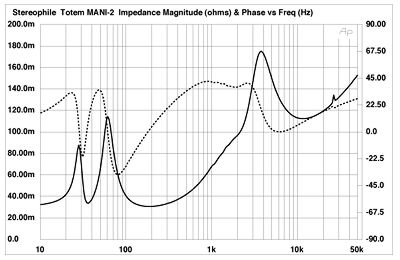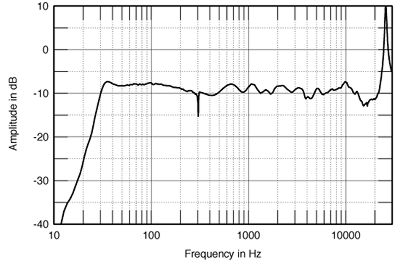| Columns Retired Columns & Blogs |
Totem Acoustic Mani-2 loudspeaker Measurements
Sidebar 3: Measurements
Other than impedance, all acoustic measurements were made with the DRA Labs MLSSA system and a calibrated B&K 4006 microphone. To minimize reflections from the test setup, the measuring microphone is flush-mounted inside the end of a long tube. Reflections of the speaker's sound from the mike stand and its hardware will be sufficiently delayed not to affect the measurement.
The use of paralleled bass units means that the Mani-2's impedance (fig.1) falls to a very low value below the midrange, reaching a current-hungry 3 ohms at 200Hz, which will be exacerbated in the octave below that frequency by highish electrical phase angle. The port tuning is revealed by the saddle in the impedance magnitude trace at 36Hz, implying good bass extension. Note the rise in impedance with frequency: taken together with the high source impedance of the single-ended Cary amplifier, this will give a tilted-up frequency response, as indeed I found in my auditioning. There are no wrinkles in the impedance traces below 1kHz, implying a freedom from strong cabinet resonances.

Fig.1 Totem Mani-2, electrical impedance (solid) and phase (dashed) (2 ohms/vertical div.).
I calculated the Mani-2's B-weighted sensitivity as a very low 80.7dB/2.83V/m. No wonder it didn't go very loud with the low-powered Cary amplifier, as delightful as the sound was. The design obviously gives up sensitivity to achieve its excellent low-bass performance. (For a given box size, a loudspeaker's sensitivity and bass extension are inversely related.)
The responses of the individual drive-units and the port can be seen in fig.2. The woofer's output is relatively evenly balanced between 100Hz and the acoustic crossover point of 3kHz—this a little lower than the specified 4kHz—though it shows a little bit of peakiness in its top octave and a half. The tweeter is also basically flat within its passband before it climbs up to a huge ultrasonic peak at 26kHz due to its "oil-can" resonance. Though it looks alarming, this peak will be inaudible to everyone other than bats and very young children. And it will, of course, not be excited to anything like its full extent with current digital sources, which have no energy above 22kHz.

Fig.2 Totem Mani-2, acoustic crossover on tweeter axis at 50", corrected for microphone response, with nearfield woofer and port responses plotted below 300Hz and 3.5kHz, respectively.
In the bass, the compound woofer rolls off smoothly below 80Hz or so to reach its minimum-motion point at a low 34Hz, the same frequency as the maximum port output. But note the very sharp peaks in the port's response at 305Hz, 550Hz, 640Hz, 1440Hz, and 2140Hz. These are due to pipe resonances and could be heard as a distinct whistle overlaying the port's output on pink noise. Fortunately, the Mani-2's port faces away from the listener, significantly reducing the effect these problems might have on the speaker's perceived sound quality.
The Mani-2's overall response on its tweeter axis, averaged across a 30 degrees horizontal window, is shown in fig.3. The overall balance is impressively flat, broken only by some small peaks and dips in the low- and mid-treble regions. The very sharp notch at 300Hz is due to the resonant port energy being out-of-phase with the woofer's output at this frequency. The notch is so narrow that its subjective effect is likely to be inconsequential. The Mani-2's bass extends down to a very low 27Hz, -6dB, with then a sharp 24dB/octave rolloff due to the reflex tuning. (Below the port tuning frequency, the outputs of the woofer and port are in opposing polarity and cancel, doubling the rate of rolloff of either on its own.)

Fig.3 Totem Mani-2, anechoic response on tweeter axis at 50", averaged across 30 degrees horizontal window and corrected for microphone response, with complex sum of nearfield woofer and port responses plotted below 300Hz.
This excellent bass extension can also be seen in the spatially averaged room response (fig.4). In fact, the 30-80Hz region is even shelved-up a little. Above the bass, the Totem's in-room balance is smooth and even, meeting astonishing ±0.5dB limits between 1600Hz and 10kHz.

Fig.4 Totem Mani-2, spatially averaged, 1/3-octave response in JA's Santa Fe room.
The Mani-2's plot of vertical dispersion (fig.5—only the changes in response are shown, which means that the on-axis response appears to be a straight line) reveals that the speaker is quite sensitive to changes in listening height. Placing your ears on or just below the tweeter axis is optimal. Stand up and the speakers will start to sound hollow, due to a suckout in appearing in the crossover region.

Fig.5 Totem Mani-2, vertical response family at 50", normalized to response on tweeter axis, from back to front: differences in response 90 degrees-5 degrees above tweeter axis; reference response; differences in response 5 degrees-90 degrees below tweeter axis.
- Log in or register to post comments




































